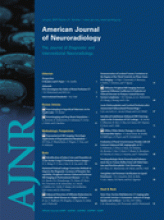Abstract
BACKGROUND AND PURPOSE: Acute hydrocephalus after aneurysmal subarachnoid hemorrhage (SAH) may decrease cerebral perfusion by increasing intracranial pressure. We studied cerebral perfusion in patients with and without acute hydrocephalus after SAH.
MATERIALS AND METHODS: We performed noncontrast CT scans, CT perfusion (CTP), and CT angiography on admission in all patients with aneurysmal SAH. Patients were dichotomized at a relative bicaudate index of 1 for the presence or absence of hydrocephalus. Cerebral perfusion was measured in the cortex, basal ganglia, and periventricular white matter. Mean CTP parameters were compared between patients with and without acute hydrocephalus (ie, within 3 days after SAH).
RESULTS: We included 138 consecutive patients with successful CTP measurements, of whom 49 (36%) had acute hydrocephalus. Mean cerebral blood flow (CBF) was lower in patients with hydrocephalus than in those without in the basal ganglia (difference of means, 6.8; 95% CI, 1.6–11.0 mL/100 g/min) and periventricular white matter (difference of means, 3.8; 95% CI, 0.9–6.8 mL/100 g/min) but not in the cortex (difference of means, 1.8; 95% CI, −2.8 to 6.4 mL/100 g/min). In all regions studied, mean transit time (MTT) and time-to-peak (TTP) were statistically significantly longer in patients with hydrocephalus, but cerebral blood volume (CBV) values were similar.
CONCLUSIONS: Acute hydrocephalus after SAH reduces CBF in the deep gray matter and periventricular white matter and delays MTT and TTP in all investigated brain areas. The negative effect of acute hydrocephalus on cerebral perfusion in patients with SAH seems more pronounced in the vicinity of the ventricles than in remote sites.
- Copyright © American Society of Neuroradiology












